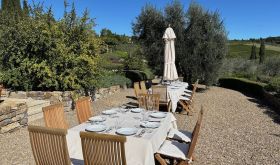Last autumn I made the four-hour drive from my base in north-east Spain to Châteauneuf. During a tour and tasting of her wines, Laëtitia Barrot of Domaine Barroche told me that they always invite a guest region to their annual Les Printemps de Châteauneuf-du-Pape three-day showcase of 86 local producers organised by the association of young growers. The atmosphere is very casual and the event is open to the public for the first two days with a professional day closing the event and making for an incredibly pleasant way to sample this Grenache-centric region of the Rhône. The plan was for this year’s event, which took place earlier this month, to feature Spain. They eventually decided to narrow this down to Catalunya, thus enabling a heavier focus on Grenache/Garnacha/Garnatxa.
When they got down to organising the event, the French were rather surprised to find how difficult it was to get any response at all from the Catalan wineries they contacted. While the French are quite responsive when it comes to email, Spain is the exact opposite. Spanish winemakers tend to view email as useful merely to communicate with importers in different time zones. Otherwise it seems as much of a nuisance as quarterly tax filings. Perhaps the Catalans thought this Châteauneuf tasting wouldn't be worthwhile because France holds no market value for them. But if I were a winemaker in Catalunya, a region bordering France, I would jump at an invitation to an event in an internationally celebrated AOC such as Châteauneuf. For me, Châteauneuf and Gigondas are the French equivalents of Priorat and Montsant, and seeing how those in the southern Rhône work in the vineyards, cellars, and selling of their wines would surely present a great opportunity for cultural wine exchange.
Because of my local connections, I was recruited to improve the Catalan response rate and eventually seven Catalan wineries made the trip to Châteauneuf: Lagravera in DO Costers del Segre, Celler de Capçanes and Vinyes Domènech in DO Montsant, Bodegas Mas Alta and Merum Priorati in DOQ Priorat and La Vinyeta in DO Empordà, as well as Epicure Wines presenting their DO Terra Alta wine. They were hosted by various domaines in Châteauneuf and were given free stands at which to pour their wines during the fair. They were also the focus of a tasting workshop called ‘Return to the origins of Grenache’ at which their wines were shown in contrast to the Châteauneufs of Domaine Cristia, Domaine de Barville, Château Simian, Vignobles Mayard, and Domaine Eddie Feraud. The Catalans were also free to taste any of the wines at the fair as well as visit the local domaines – and they were inducted into the local wine confrérie, the Echansonnerie des Papes.

It was perhaps not surprising that during the workshop there was some discussion of why some other Catalan producers had decided not to make the trip. One audience member spoke up to ask, ‘With climate change, will you be able to find some finesse in your wines?’ The Catalan winemakers seemed generally unfazed by this rather barbed comment and Joan Ignasi of Vinyes Domènech calmly replied along the lines of, ‘We are already making the wines that are correct to make for our region.’
An acidic question such as this was perhaps to be expected, as several Catalan winemakers told me that it had been difficult to get attendees at the fair to taste their wines. One Spanish winemaker thought that the French may have been turned off by seeing such low prices and suspected the wines of being mere plonk. He ‘adjusted’ his prices appropriately later in the day and was met with more interest.
Overall this was an exchange with great potential as north-east Spain and southern France share many commonalities such as their push to have Grenache be seen as a more respected grape and not just a rustic ingredient in a blend that you try to smother as much as possible [see, for example, Julia's account of the 2010 Grenache Symposium – JR]. While I still encounter many top sommeliers who think the contrary, Grenache/Garnacha/Garnatxa is as revered a grape in Châteauneuf as it is in Priorat.
But more than Grenache, these regions also share similar climates, history, and language, with Catalan and Occitan being siblings. The takeaway from these three days, however, was that if Catalan winemakers see little point in going to such a closely related region and the wine drinkers of that region see little merit in drinking wines from a bit further south with very similar grape blends and climate, then more of these exchanges are most definitely needed.
This was the sixth edition of Les Printemps de Châteauneuf-du-Pape. For the day of the professional tasting, they had a long table with all the reds and whites of the just-released 2013 vintage available to taste. As Jancis noted in her review of the wines last November, it's definitely a lighter vintage. The winemakers I talked to said that, in response to the less marked ripeness than usual, they generally included fewer stems than usual – about 20% in 2013 rather than the more usual 50%. On the other hand, the 2012 Châteauneufs really spoke to me during the tastings, with their fuller body and more markedly ripe fruit, they lingered on the palate – although this is probably not a surprise to hear from one who regularly drinks north-eastern Spanish wines.













